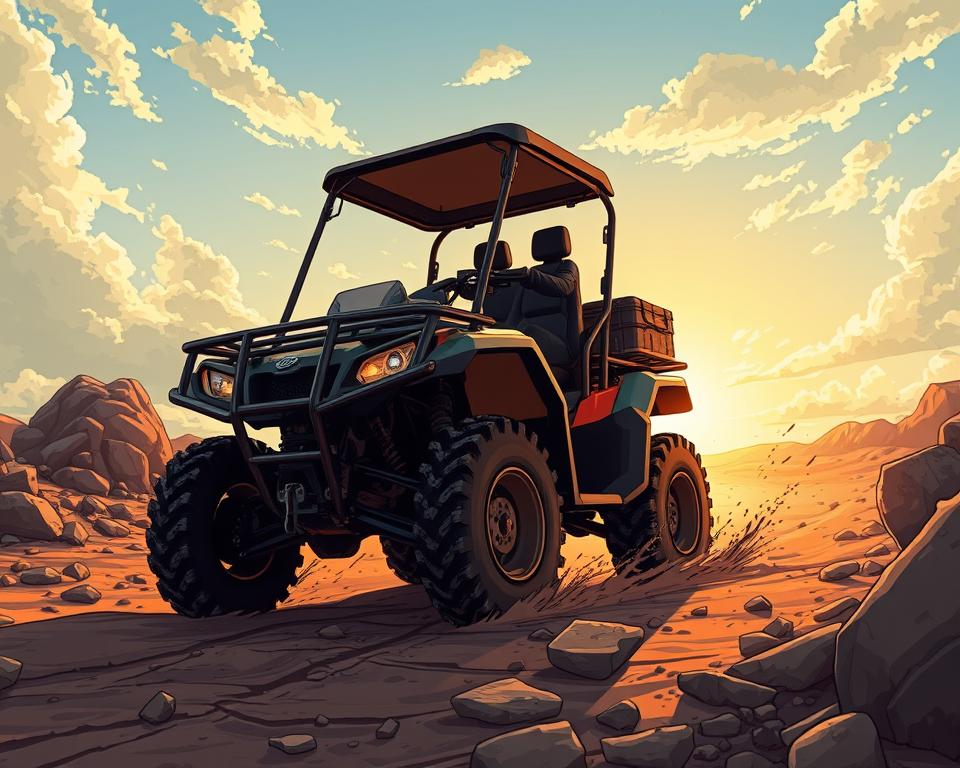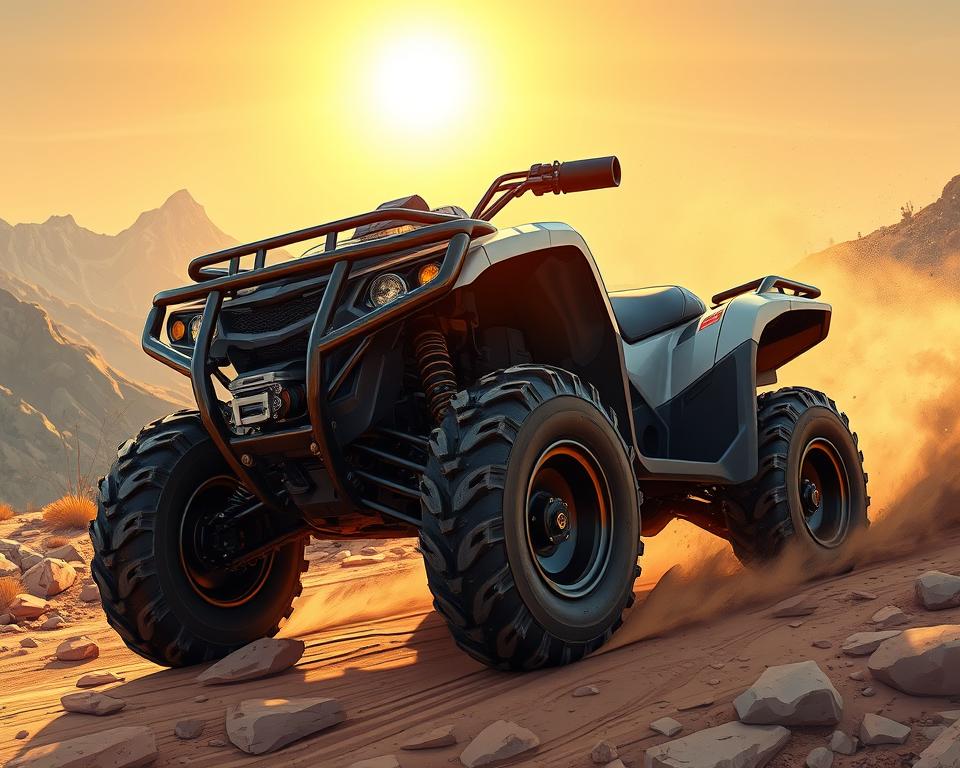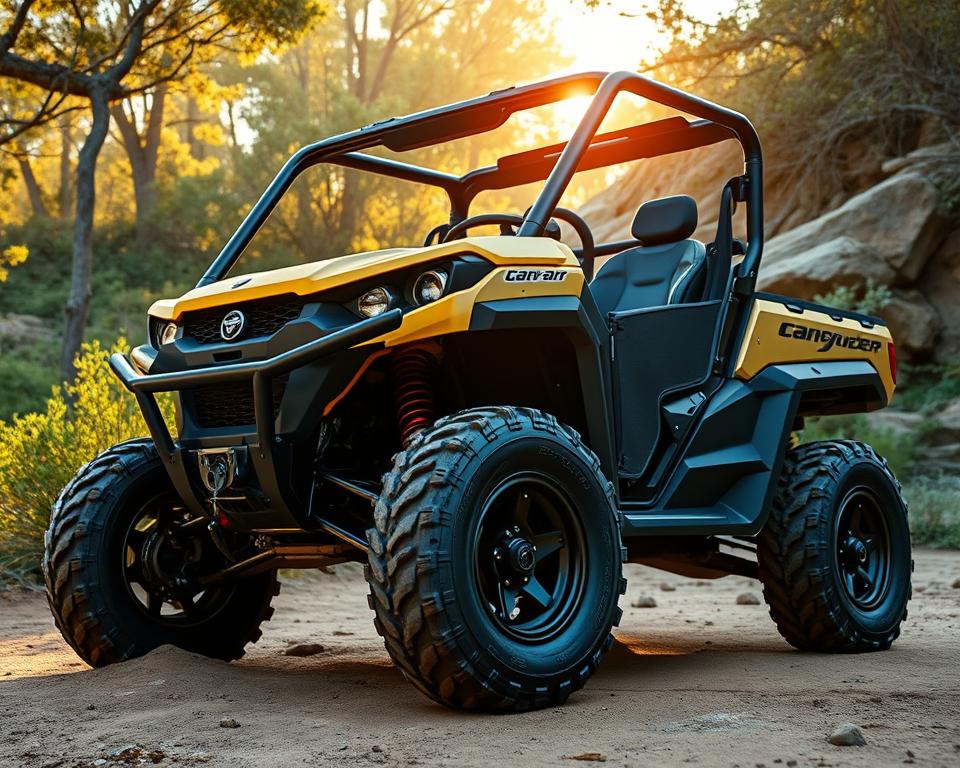Essential ATV Off-Road Checklist for Safe Riding
You might be surprised to learn nearly 450,000 ATV-related injuries are treated in U.S. emergency rooms each year? This alarming figure highlights the need for safety and preparedness in off-road adventures. The Essential ATV Off-Road Checklist is your guide to a safe and enjoyable ride. Whether you’re tackling rocks or dunes, it’s all included. Equipped with top safety gear plus moose UTV accessories necessities, you’ll ride safer and with more confidence.
Main Points
- Use this checklist first to prep safely and thoroughly.
- Your gear list is critical for staying protected off-road.
- Keep your ATV running smoothly with routine care.
- Hydration and nutrition boost endurance and focus on long rides.
- Don’t wander: rely on trusty navigation tools.
- Pack layers and waterproofs for all conditions.
- Always carry essential tools and recovery kits for on-trail repairs and emergencies.
Understanding the Importance of Safety Gear
When you ride off-road, safety must come first. The excitement of ATVs brings potential hazards. Safety gear is essential for protecting riders from accidents and injuries. Being well-equipped ensures a safer ride and follows an ATV safety gear checklist.

Essential Protective Gear
Maximizing protection involves several key items:
- Helmets: Always use a DOT helmet to guard against head trauma.
- Eye Protection: Use goggles to shield your eyes from dust and debris.
- Gloves: Grip and guard your hands with sturdy gloves.
- Footwear: Wear sturdy boots that cover the ankles to prevent injuries.
- Body Armor: Aggressive riders should consider body armor for extra security.
- Neck Protection: A neck brace protects your spine in a crash.
Emergency Preparedness
Don’t overlook your emergency kit. Your emergency bag could be your best friend. Key items to include are:
- First aid kit
- Multi-tool
- Tire repair kits
- Portable air compressors
- Emergency blankets
- Whistles
- Matches
ATV Equipment for Optimal Performance
Proper equipment is essential for boosting your ATV’s performance on trails. Pack these essentials for any trail. Regularly following an ATV maintenance checklist helps maintain your machine’s functionality and longevity.
Must-Have ATV Equipment
- All-Terrain Tires: Invest in tires designed for various terrains to improve traction and handling.
- Cargo Systems: Keep tools and spares within reach.
- Quality Fuel Tank: Opt for a robust tank to avoid drips and dry runs.
- First Aid Kit: Prepare for emergencies with a well-stocked first aid kit for immediate attention if needed.
Regular Maintenance for Longevity
A maintenance schedule is your ATV’s best friend. Regular inspections should encompass:
- A clean air filter = a happy engine.
- Grease your chain often to avoid skip and wear.
- Inspecting brakes for safety before each ride.
Follow these steps to prep your ride for every trail.
The Essential ATV Off-Road Checklist
Good prep keeps surprise breakdowns away. An effective ATV maintenance checklist ensures your vehicle’s safety and performance. Cover every item for a worry-free ride. Spend a few minutes now for peace of mind later.
Pre-Ride Inspection Basics
Before any off-road journey, a pre-ride inspection is vital. This quick evaluation helps riders identify and address issues before they start. Key elements to check include:
- Tire pressure and tread condition
- Fluid levels such as oil and fuel
- Brakes and controls functionality
- Operational lights and horn
- Chain or driveshaft integrity
T-CLOC Inspection Method
Use T-CLOC for a thorough pre-ride check. Five key areas: T-CLOC ensures all are inspected. This method ensures all critical areas are covered:
| Inspection Area | Checklist Items |
|---|---|
| Tires and Wheels | Check tire pressure, inspect tread depth, look for damage |
| Controls | Test brakes, throttle, and clutch for smooth operation |
| Lights | Ensure headlights, brake lights, and indicators are functioning |
| Oil and Fuel | Check oil level, inspect for leaks, and fill fuel tank |
| Chain/Driveshaft | Examine for wear, proper tension, and lubrication |
Check everything—ride with confidence. Prevent roadside repairs with a fast check.
Hydration and Nutrition for Long Rides
Long ATV rides require careful attention to hydration and nutrition. Always carry more water than you think you’ll need. Carry extra water to prevent fatigue and keep energy levels up during the adventure. Pack high-energy bites to keep you going.
Importance of Staying Hydrated
Hydration is critical for ATV riders to stay alert and capable throughout their journey. It’s important to drink water consistently, not just when thirsty. Hydration bladders track consumption at a glance.
High-Energy Snacks to Pack
The right fuel makes the ride smoother. Choose items that won’t spoil in heat. Some ideal choices include:
- Protein bars
- Nut mixes
- Dried fruits
- Beef jerky
Grab-and-go snacks let you refuel on the move. Mix sweet and salty options for flavor and function.
Navigation Tools for Off-Roading Adventures
Lose fear of getting lost with the right nav gear. A dependable nav setup means you’ll always find your way.
Advanced GPS Systems
High-end GPS units guide you through the wild. Choose units with rugged builds, offline charts, and extended runtime. Garmin and TomTom lead the pack for trail GPS.
Traditional Navigation Aids
Always carry a paper map along with your GPS. Maps won’t die when batteries do. Wind your own way with map and compass skills. Tech plus tools equals total navigation readiness.
Communication Equipment for Safety
When phones fail, two-way radios deliver. Communication gear is as critical as your helmet. Knowing you can call for help reduces stress.
For seamless communication among group members, a quality two-way radio is highly recommended. Pick units with strong, clear signal range. Get instant alerts about obstacles ahead. When choosing two-way radios, look for models with:
- Weatherproof construction to resist the elements
- Long battery life for extended trips without needing a recharge
- Multiple channels for clear communication without interference
Adding ATV communication gear to your adventure prep is essential. They keep everyone coordinated and secure. Radios cut through noise and barriers. Stay connected, stay safe.
Self-Rescue Gear for ATV Riders
Every ATV rider should be ready for unexpected situations on the trail. With the right kit, you’ll tackle obstacles solo. Being self-sufficient elevates confidence and safety.
Winches and Recovery Kits
Winches are vital for self-rescue, helping pull your ATV from tough spots. Combine winch power with the right accessories. Recovery kits usually include:
- Tow straps
- D-rings
- Recovery boards
- Gloves
Knowledge plus gear equals true self-rescue. With quality ATV recovery kits, you can overcome mud, rocks, or other obstacles and continue your journey.
Trail Recovery Essentials
Your toolbox should extend beyond the winch. These include:
| Equipment | Purpose |
|---|---|
| Recovery Straps | Used for towing or pulling ATVs out of tight situations. |
| Shovel | Helps clear obstacles and dig out vehicles when stuck. |
| Traction Mats | Provides grip under tires in muddy or slick conditions. |
| Portable Air Compressor | Enables quick tire inflation after deflating for better traction. |
Arming your ATV with the right self-rescue gear ensures you can handle any obstacles. Practice rescues so you’re ready when it counts.
Staying Adaptable: Preparing for Weather Changes
Trail weather can change in minutes. It’s vital to be ready for sudden changes to stay safe and enjoy the ride. Don’t forget your layers and rain shell.
Layer up, shed as needed. Begin with a moisture-wicking base layer to manage sweat. Then, add insulating layers like fleece or wool that can be removed as needed. Your shell fights off wind and rain. This setup ensures you stay comfortable, no matter the weather.
Weather-Appropriate Clothing
- Rain Shells: Stay dry when the sky opens up.
- Ventilated Off-Road Pants: Stay cool and dry with breathable pants.
- UV Gear: Sun-blocking shirts and hats prevent overexposure.
- Insulated Gloves: Warm gloves maintain dexterity in chill.
Don’t let the weather ruin your ride. It keeps you comfortable and safe, letting you enjoy the adventure without worrying about the weather.
Tools for On-Trail Repairs
Having the right tools for on-trail repairs is key to a safe and enjoyable off-roading experience. It’s vital to carry reliable ATV repair tools. These tools help address minor breakdowns or issues that may arise during your adventure.
Must-Have Tools and Kits
A well-prepared rider should assemble a basic tool kit. A compact kit with everything you need. Critical ATV repair tools might include:
- Tire irons for changing flat tires
- Pliers for gripping and cutting
- Wrenches for various sizes of bolts and nuts
- A multi-tool for versatility
- Spare items such as spark plugs and electrical wire
- Duct tape for quick fixes
Be your own mechanic on the trail.
Basic Emergency Supplies
Tools alone won’t save you—bring these extras. These supplies help ensure your safety in challenging situations:
- First aid kit for injuries
- Flashlight with extra batteries for night-time visibility
- Emergency whistle for signaling assistance
- Reflective triangles or flares to warn other riders
- Water and high-energy snacks for sustenance
Be ready for the unexpected. Never leave home without them.
To Summarize
Well-planned rides are the best rides. Using the Essential ATV off-road checklist and acquiring gear from trusted sources is key. Ride confidently on every surface.
Gear up fully and ride securely. Prep wisely for peak thrills and protection. It lets you enjoy the thrill of off-road adventures without worry.
Gear up, stay sharp, and savor every off-road second. The journey is as important as the destination. By following the Essential ATV off-road checklist, you’re set for an incredible adventure in the great outdoors.
FAQ
What should I include in my ATV safety gear checklist?
Your ATV safety gear checklist should include a DOT-approved helmet and goggles. Gloves, suitable footwear, and body armor are also necessary. Consider a neck brace for extra safety. Also bring a medical kit and adaptable multi-tool.
Tips for ATV upkeep?
Inspect air filters and grease the chain often. Don’t ignore brake checks. A consistent maintenance routine extends your machine’s life and keeps it ready for off-road adventures.
What does the T-CLOC inspection method entail?
T-CLOC inspects five critical systems. Cover Tires, Controls, Lights, Oil/Fuel, Chain in T-CLOC. This ensures your ATV’s critical components are in working order before hitting the trails.
How to gauge water needs off-road?
Carrying more water than you think you’ll need is essential. Stay topped off to avoid dehydration. Hydro packs let you drink without stopping.
How to stay on course off-road?
For navigation, invest in an advanced GPS system designed for off-road use. Backup with maps and a compass ensures you never get lost.
Why is communication important when off-roading?
Comms keep groups connected and safe. Areas with limited cell service highlight the need for reliable two-way radios.
Essential recovery gear for off-road?
Be ready with winch and recovery essentials. Have straps, shackles, mats, and gloves on hand.
How can I prepare for sudden weather changes while off-roading?
Layer up and down as conditions shift. Don’t get caught soaked—bring waterproofs. Wear sun-blocking fabrics and hats.
What tools should I pack for on-trail repairs?
For on-trail repairs, pack a basic tool kit for minor fixes. Include tire irons, pliers, wrenches, a multi-tool, and spare parts like a spark plug.


